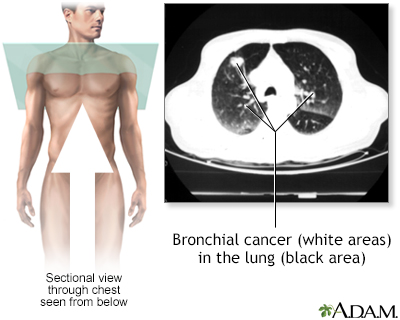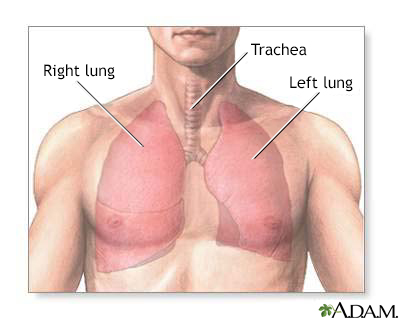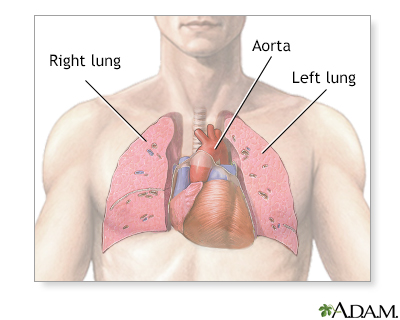Pregnancy SmartSiteTM
Thoracic CT; CT scan - lungs; CT scan - chest DefinitionA chest CT (computed tomography) scan is an imaging method that uses x-rays to create cross-sectional pictures of the chest and upper abdomen. How the Test is PerformedThe test is done in the following way:
The complete scan takes 30 seconds to a few minutes. Certain CT scans require a special dye, called contrast, to be delivered into the body before the test starts. Contrast highlights specific areas inside the body and creates a clearer image. If your health care provider requests a CT scan with intravenous contrast, you will be given it through a vein (IV) in your arm or hand. A blood test to measure your kidney function may be done before the test. This test is to make sure your kidneys are healthy enough to filter the contrast. You may be given medicine to help you relax during the test. How to Prepare for the TestTell your provider if you are pregnant. Chest CT scans are generally avoided during pregnancy, and special precautions are taken if they are needed. Some people have allergies to IV contrast and may need to take medicine before their test to safely receive this substance. If contrast is used, you may also be asked not to eat or drink anything for 4 to 6 hours before the test. If you weigh more than 300 pounds (lb) or 136 kilograms (kg), have your provider contact the scanner operator before the exam. CT scanners have an upper weight limit of 450 lb (204 kg). Some newer scanners can accommodate up to 680 lb (308 kg). Because it is hard for x-rays to pass through metal, you will be asked to remove jewelry. How the Test will FeelSome people may have discomfort from lying on the hard table. Contrast given through an IV may cause a slight burning sensation, a metallic taste in the mouth, and a warm flushing of the body. These sensations are normal and usually go away within a few seconds. There is no recovery time, unless you were given medicine to relax. After a CT scan, you can go back to your normal diet, activity, and medicines. Why the Test is PerformedA CT scan quickly creates detailed pictures of the body. The test may be used to get a better view of the structures inside the chest. A CT scan is one of the best ways of looking at soft tissues such as the heart and lungs. A chest CT may be done:
What Abnormal Results MeanA chest CT may show many disorders of the heart, lungs, mediastinum, or chest area, including:
RisksCT scans and other x-rays are strictly monitored and regulated to make sure they use the least amount of radiation. CT scans use low levels of ionizing radiation, which has the potential to cause cancer and other defects. However, the risk from any one scan is small. The risk increases as many more scans are done. The most common type of contrast given into a vein contains iodine. If a person with an iodine allergy is given this type of contrast, nausea, sneezing, vomiting, itching, or hives may occur. In rare cases, the dye can cause a life-threatening allergic response called anaphylaxis. If you have any trouble breathing during the test, you should notify the scanner operator immediately. Scanners come with an intercom and speakers, so the operator can hear you at all times. In people with kidney problems, the dye may have harmful effects on the kidneys. In these situations, special steps may be taken to make the contrast dye safer to use. In spite of its risks, a CT scan may still be done if the benefits greatly outweigh the risks. For example, it can be more risky to not have the exam if your provider thinks you might have cancer. Considerations
ReferencesJokerst CE, Gotway MB. Thoracic radiology: noninvasive diagnostic imaging. In: Broaddus VC, Ernst JD, King TE, et al, eds. Murray and Nadel's Textbook of Respiratory Medicine. 7th ed. Philadelphia, PA: Elsevier; 2022:chap 20. Nair A, Barnett JL, Semple TR. Current status of thoracic imaging. In: Adam A, Dixon AK, Gillard JH, Schaefer-Prokop CM, eds. Grainger & Allison's Diagnostic Radiology. 7th ed. Philadelphia, PA: Elsevier; 2021:chap 1. | ||
| ||
Review Date: 8/19/2024 Reviewed By: Allen J. Blaivas, DO, Division of Pulmonary, Critical Care, and Sleep Medicine, VA New Jersey Health Care System, Clinical Assistant Professor, Rutgers New Jersey Medical School, East Orange, NJ. Review provided by VeriMed Healthcare Network. Also reviewed by David C. Dugdale, MD, Medical Director, Brenda Conaway, Editorial Director, and the A.D.A.M. Editorial team. View References The information provided herein should not be used during any medical emergency or for the diagnosis or treatment of any medical condition. A licensed medical professional should be consulted for diagnosis and treatment of any and all medical conditions. Links to other sites are provided for information only -- they do not constitute endorsements of those other sites. No warranty of any kind, either expressed or implied, is made as to the accuracy, reliability, timeliness, or correctness of any translations made by a third-party service of the information provided herein into any other language. © 1997- A.D.A.M., a business unit of Ebix, Inc. Any duplication or distribution of the information contained herein is strictly prohibited. | ||


 CT scan
CT scan Thyroid cancer - C...
Thyroid cancer - C... Pulmonary nodule, ...
Pulmonary nodule, ... Lung mass, right u...
Lung mass, right u... Bronchial cancer -...
Bronchial cancer -... Lung mass, right l...
Lung mass, right l... Lung nodule, right...
Lung nodule, right... Lung with squamous...
Lung with squamous... Vertebra, thoracic...
Vertebra, thoracic... Normal lung anatom
Normal lung anatom Thoracic organs
Thoracic organs
